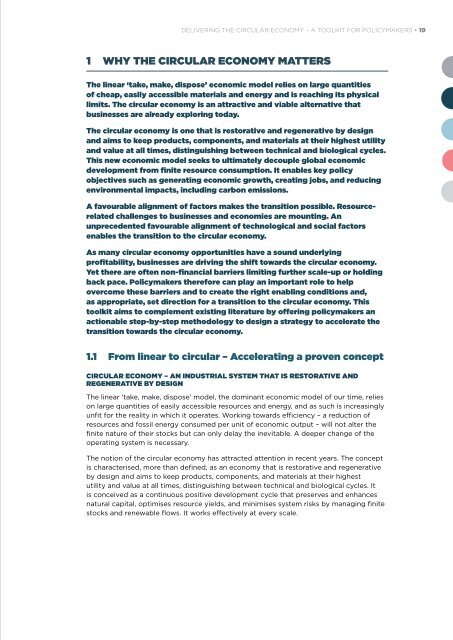DELIVERING THE CIRCULAR ECONOMY A TOOLKIT FOR POLICYMAKERS
20150924_Policymakers-Toolkit_Active-links
20150924_Policymakers-Toolkit_Active-links
Create successful ePaper yourself
Turn your PDF publications into a flip-book with our unique Google optimized e-Paper software.
<strong>DELIVERING</strong> <strong>THE</strong> <strong>CIRCULAR</strong> <strong>ECONOMY</strong> – A <strong>TOOLKIT</strong> <strong>FOR</strong> <strong>POLICYMAKERS</strong> • 19<br />
1 WHY <strong>THE</strong> <strong>CIRCULAR</strong> <strong>ECONOMY</strong> MATTERS<br />
The linear ‘take, make, dispose’ economic model relies on large quantities<br />
of cheap, easily accessible materials and energy and is reaching its physical<br />
limits. The circular economy is an attractive and viable alternative that<br />
businesses are already exploring today.<br />
The circular economy is one that is restorative and regenerative by design<br />
and aims to keep products, components, and materials at their highest utility<br />
and value at all times, distinguishing between technical and biological cycles.<br />
This new economic model seeks to ultimately decouple global economic<br />
development from finite resource consumption. It enables key policy<br />
objectives such as generating economic growth, creating jobs, and reducing<br />
environmental impacts, including carbon emissions.<br />
A favourable alignment of factors makes the transition possible. Resourcerelated<br />
challenges to businesses and economies are mounting. An<br />
unprecedented favourable alignment of technological and social factors<br />
enables the transition to the circular economy.<br />
As many circular economy opportunities have a sound underlying<br />
profitability, businesses are driving the shift towards the circular economy.<br />
Yet there are often non-financial barriers limiting further scale-up or holding<br />
back pace. Policymakers therefore can play an important role to help<br />
overcome these barriers and to create the right enabling conditions and,<br />
as appropriate, set direction for a transition to the circular economy. This<br />
toolkit aims to complement existing literature by offering policymakers an<br />
actionable step-by-step methodology to design a strategy to accelerate the<br />
transition towards the circular economy.<br />
1.1 From linear to circular – Accelerating a proven concept<br />
<strong>CIRCULAR</strong> <strong>ECONOMY</strong> – AN INDUSTRIAL SYSTEM THAT IS RESTORATIVE AND<br />
REGENERATIVE BY DESIGN<br />
The linear ‘take, make, dispose’ model, the dominant economic model of our time, relies<br />
on large quantities of easily accessible resources and energy, and as such is increasingly<br />
unfit for the reality in which it operates. Working towards efficiency – a reduction of<br />
resources and fossil energy consumed per unit of economic output – will not alter the<br />
finite nature of their stocks but can only delay the inevitable. A deeper change of the<br />
operating system is necessary.<br />
The notion of the circular economy has attracted attention in recent years. The concept<br />
is characterised, more than defined, as an economy that is restorative and regenerative<br />
by design and aims to keep products, components, and materials at their highest<br />
utility and value at all times, distinguishing between technical and biological cycles. It<br />
is conceived as a continuous positive development cycle that preserves and enhances<br />
natural capital, optimises resource yields, and minimises system risks by managing finite<br />
stocks and renewable flows. It works effectively at every scale.



